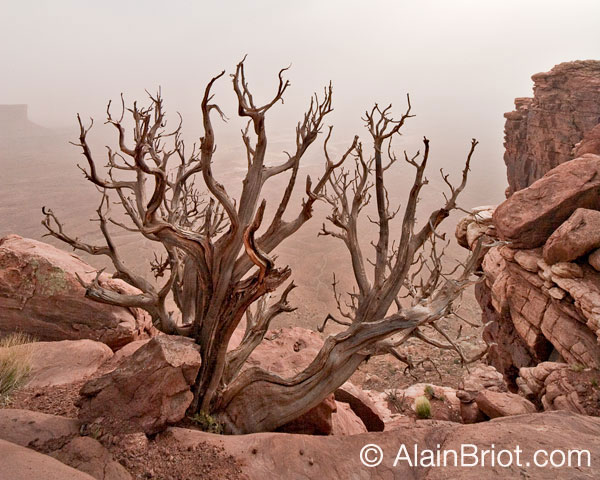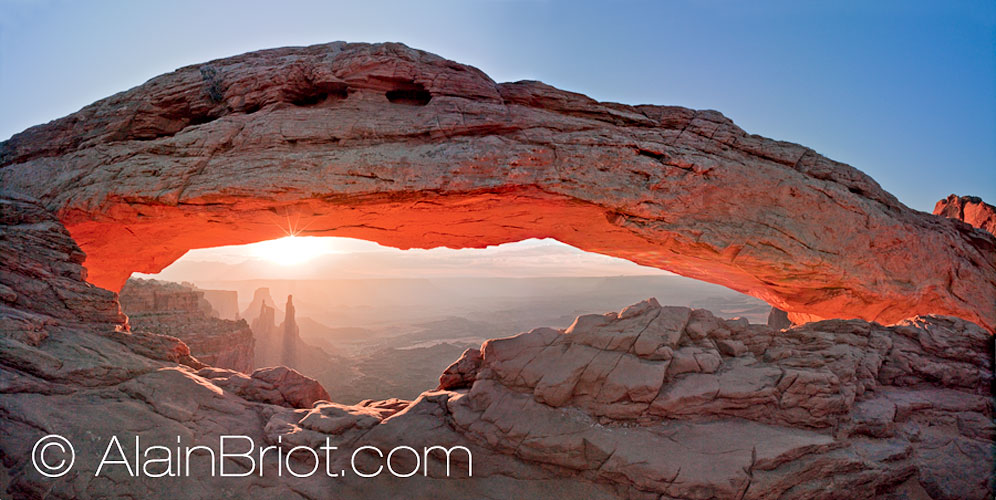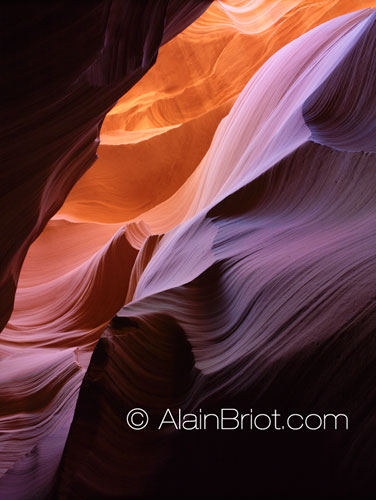Part III: The Environment

JM: How do you see the current state of environmental affairs - both at home and globally?
AB: I think that the environment is something we need to be concerned about as landscape photographers. After all, it is our subject, and if it disappears, or is damaged beyond repair, what are we going to photograph? So I think that this is an important subject, and one that is not discussed enough among landscape photographers in my view. Thereís numerous issues that threaten the environment, and as landscape photographers we are in a position to see the outcome of these issues first hand because we spend a lot of time out in the wilderness looking at the landscape.
JM: What do you see as your role, if any, in these issues?
AB: I think that most, if not all, landscape photographers want to see the environment protected. The problem, though is finding out how we can protect it, what role we can play in either preventing or stopping the damage. It seems that a lot of what needs to be done is out of our hands, requiring legal action rather than just a love for nature. Most of us do not want to get involved in legal matters, or in lobbying for changes, or even in nature protection movements of one kind or another and that makes things difficult.
My impression is that one of the first things to do is to put forth a concern for the environment so as to bring an awareness in the general public that the natural beauty we are photographing, the natural beauty we are sharing in our work, is at risk, is under attack, and may not be there forever. This is especially the case for amateur photographer, meaning photographers who do not make a living from their work. Let me explain.
Professionals are quite often involved in one nature protection movement, or association, or another, because it is a logical outlet for their work. Even if they are not paid for the use of their images, or are paid relatively little, this is a good way to promote both their work and the work of various environmental groups. And again, there can be a good source of income from this type of venue. So at that level, we can say that many professional nature photographers see their images used towards protecting the environment in one way or another. From there it is only a step away, for these photographers, to talk about how their images are being used, and from there to taking a position in regards to specific environmental issues. Usually, this position is local, rather than global, since it is related to using photographs of specific places.
When it comes to amateur landscape photographers, meaning photographers who do not make a living from their work, relationships with environmental groups, or associations, is far less common. That is often because amateur photographers see a gallery, or an art show, or again a stock agency, as choice outlets for their work. Amateur rarely engage in active marketing, i.e. contacting environmental organizations directly in this instance, preferring to rely on venues that already have a built-in channel for selling photographs. Galleries, art shows and stock agencies have such a built-in channel. They not only expect submissions, they depend on these submissions to make an income. But other organizations, such as environmental protection groups, do not have such a channel. Submissions are not so frequent, and when they take place there is no application form to fill in, no specific person to contact, and so on. One must make the call and work things out on a case-by-case basis. It takes a lot more motivation and self-assurance to contact an environment organization out of the blue than it takes to fill in an application form for a show, or a stock agency, or even show your work to a gallery owner for whom this is a daily event.
All this to say that more work is involved, and that the benefits are not obvious and may not be financial at all. But, the benefit is that one helps bring attention to environmental causes, and one does bring attention to oneís own work, so in that respect it is a win-win situation. And many things can be worked out once such relationship is started, things that can benefit both parties, such as a show in which a percentage of the proceeds from the sale of the photographs is donated to a specific environmental protection group. This is a very simple approach, and one that is rarely, if ever, turned down as it is clearly a win-win situation.

I also think there are many things we can do personally. For example, now that we are seeing the introduction of hybrid-fuel vehicles, driving a hybrid car or SUV is an excellent way to show our concern for the environment and to take an active role in reducing damage coming from burning fossil fuels. I understand that hybrid vehicles are still more expensive than comparable gasoline-only vehicles, but the difference is bound to get smaller and smaller. We can also expect more practical hybrid vehicles, such as 4x4 SUVís or trucks, something necessary, at least for me, to reach the locations I am photographing. I would definitely buy a hybrid 4x4 medium-sized truck if one was available. Knowing that I am helping reduce emissions by driving it would be enough for me to rationalize this purchase. The fact that it would save me money on fuel in the long run would be secondary, though important as well.
I do think that as nature photographers we need to first, become aware of how much the vehicles we drive damage the environment through the exhaust gases they emit. On average, photographers drive some of the largest 4x4, trucks or SUVís. Photographers also drive a lot of miles each year. So moving to hybrid trucks, SUV, or cars if you donít need the larger size vehicle, would definitely be a huge step forward. Not only that, but it would set an example by showing to others that our concerns for the environment is demonstrated by our adoption of hybrid vehicles technology. I think we owe it to our subject -to nature and to the environment- to make that one contribution, that one change.
Another thing we can do is take an active role in not damaging the environment any more than it already is. I personally do not drive off road or hike off trail in fragile terrain, such as cryptogamic soil, and I also pick up any litter that I find along my way. I know this may sound like small steps when compared to larger problems like acid rain, global warming, or damming a river, but these are steps I can conduct myself, and which do make a difference if they are conducted by a large number of people. I also own land that I keep in a natural state, undeveloped, and which I purchased for its photogenic qualities. Natalie and I own three 40-acre parcels at this time. It may be a drop in the bucket, but again it is something I can do.
JM: Are there any organizations that you specifically feel are doing great work at protecting the environment?
AB: I hesitate to recommend specific environmental organizations. I feel that what is most important is that if you choose to support such an organization, you select one that is willing to work with you, and preferably one that is located near where you live, or has an office near where you live, and is working on protecting an area that you are able to photograph so that you can work with them and make use of your photography.
JM: Hybrid SUVs are seen to be great for city dwellers. Do you see a significant difference in fuel economy living in a place like Arizona?. My wife and I are debating a move to Wyoming and have been considering an Escape Hybrid. However, I am concerned that most my mileage will not be City driving.
AB: I am most familiar with the Toyota Hybrids, both the Prius and the Highlander Hybrid, which to my understanding have the highest mileage per gallon of all hybrids, and from what I know the fuel efficiency is excellent both in the city and on the open road. I think that, in terms of maximizing fuel efficiency with a hybrid vehicle, what matters most is not where you drive it, but rather how you drive it and in this regards it is our driving habits that we have to work on. For example, accelerating and decelerating progressively, rather than suddenly, are key to increasing fuel economy with a Hybrid, and this approach is totally different than driving a muscle car, to go to the extreme, or driving in a "racing" fashion, or again an aggressive fashion, to try and describe some of the different driving habits that are out there. In this respect we may have to get out of our collective unconscious the fact that to be accelerating and decelerating progressively is neither passive or submissive but rather responsible and oriented towards fuel economy. Our speed of travel is also key, and driving at the speed limit, rather than as fast as we can get away with, is also key to maximizing fuel economy. In other words, our lack of concern for fuel consumption, as a society, is not reflected only in our choice of vehicles but also by our driving habits and styles. We need to change more than just the cars we drive.

There are many myths out there in terms of what Hybrids can do for us in terms of helping us save fossil fuels. I mentioned to a friend recently, after he remarked that the environment was getting more and more damaged, that he should get a hybrid vehicle. His response was that "Hybrid cars are coming too late." My reply was that they were coming just in time. Sometimes I think that there is a feeling of helplessness in front of the problem on the part of a number of people, and that they don't realize how much of a difference they can make should they decide to be pro-active rather than passive. This person, who is concerned with the environment, went on to buy a new gasoline only car, and spent as much as if he had bought a Prius Hybrid. In fact, the car he chose was very close in shape and size to the Prius...
If you are interested in learning more about Alain Briot, you can visit [url= http://beautiful-landscape.com]
http://beautiful-landscape.com[/url].
As always, we encourage you to come join the community and to be participants in the
forums.